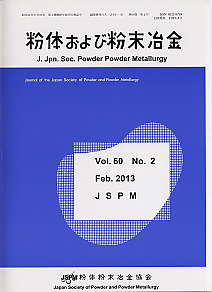All issues

Volume 60, Issue 8
August
Displaying 1-6 of 6 articles from this issue
- |<
- <
- 1
- >
- >|
Paper
Paper
-
Yohei MATSUOKA, Takuya FUJIMA, Ai MOMOZAWA, Ken-ichi TAKAGI2013 Volume 60 Issue 8 Pages 349-353
Published: August 15, 2013
Released on J-STAGE: September 21, 2013
JOURNAL OPEN ACCESSW2NiB2 – Ni ternary boride cermet was studied for use as wear resistant hard materials. Microstructure configuration and mechanical properties of W2NiB2 – Ni ternary boride cermet were investigated, such as transverse rupture strength and Rockwell A hardness in different W/B ratios. The existence of W2B phase with W/B = 1.05, 1.10 samples leads the microstructure refinement. W2NiB2 – Ni ternary boride cermet showed mechanical properties of HRA86.0 in hardness, and 1.48 GPa in transverse rupture strength with W/B = 1.00 sample. W2NiB2 – Ni ternary boride cermet needs improve mechanical properties to be an alternative material to wear resistant hard materials such as WC – Co.View full abstractDownload PDF (1167K) -
Akira TOMINAGA, Takashi ITOH2013 Volume 60 Issue 8 Pages 354-359
Published: August 15, 2013
Released on J-STAGE: September 21, 2013
JOURNAL OPEN ACCESSDimagnesium silicide (Mg2Si) is a promising n – type thermoelectric compound suitable for thermoelectric power generation using waste heat of intermediate temperature range (600 − 900 K). However, there are two problems in making the Mg2Si compound. One is difficulty in synthesizing the compound due to ease of Mg evaporation in fusion, resulting in existence of non-reacting Si. Another is difficulty in sintering the synthesized powder. In order to overcome the two problems, we synthesized the Mg2Si compound on Mg – rich state by the liquid-solid phase reaction and sintered the synthesized powder by the pulse discharge sintering (PDS). The influences of Mg/Si ratio and B addition on the sinterability and the thermoelectric properties of the synthesized Mg2Si compounds were investigated. The sinterability of the synthesized Mg2Si compounds were improved by the increase of Mg amount. And, electrical resistivities of sintered samples were decreased by B addition. Therefore, thermoelectric properties were strongly affected by both Mg/Si ratio and B addition. The sample synthesized with feed amount of Mg of 67.00 at% and additive amount of B of 1.0 at% had the maximum dimensionless figure of merit of about 0.39 at 773 K.View full abstractDownload PDF (1598K) -
Tomotake TOHEI , Shinichi FUJIWARA, Takahiro JINUSHI, Zenzo ISHIJIM ...2013 Volume 60 Issue 8 Pages 360-366
Published: August 15, 2013
Released on J-STAGE: September 21, 2013
JOURNAL OPEN ACCESSA new method that is low cost and produces highly reliable refractory bonds was developed for bonding Si – Ge thermoelectric devices and Mo electrodes. Aluminum foil was chosen as an alternative material to conventional Ag alloy paste, because of its cost advantages and bonding ability. Good wettability of Al to both the Si – Ge devices and Mo electrodes was achieved at a bonding temperature of 953 K. For 12.5 µm – thick Al foil, almost no degradation of the joint strength occurred after heat treatment at 823 K for 18000 s, because the reaction of the thin Al bonding layer to Si – Ge was completed during the bonding process. Comparable conversion efficiency of Si – Ge device was achieved between Al and Ag paste bonding.View full abstractDownload PDF (1649K) -
Hoshiaki TERAO, Hideaki KOBIKI, Hiroki OTA, Takashi ITOH, Naoyuki KA ...2013 Volume 60 Issue 8 Pages 367-372
Published: August 15, 2013
Released on J-STAGE: September 21, 2013
JOURNAL OPEN ACCESSCr – Cu materials have been developed for heat-sink application using P/M processing: Cr powder is sintered and Cu infiltrated. W – Cu and Mo – Cu materials, with low thermal expansion and high thermal conductivity, have been used for heat-sink application. However parts of these materials are produced using expensive powders. Chromium is also a strong candidate for the heat-sink application, because it is the same 6A group element as W and Mo, its powder price is lower and more stable. Cr – Cu materials have succeeded in substitution for W – Cu and Mo – Cu materials. For the heat-sink application, pore free and inclusion free structure of Cr – Cu infiltrated compact is essential for the ability of the following processes: rolling, pressing and Ni plating, to make heat-sink parts. Carbon and oxygen contents of sintered Cr are found to have an effect on the infiltration ability. For the pore free and inclusion free structure, carbon content and oxygen content of sintered Cr should be lower than 0.01 mass% respectively.View full abstractDownload PDF (1689K)
JSPM Announcement
-
2013 Volume 60 Issue 8 Pages Pref8_1-
Published: August 15, 2013
Released on J-STAGE: September 21, 2013
JOURNAL OPEN ACCESSDownload PDF (928K) -
2013 Volume 60 Issue 8 Pages Mtg8_2-Mtg8_6
Published: August 15, 2013
Released on J-STAGE: September 21, 2013
JOURNAL OPEN ACCESSDownload PDF (264K)
- |<
- <
- 1
- >
- >|